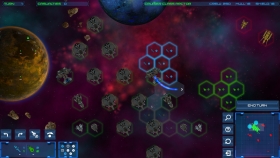
Human Extinction Simulator Review
I’ve dipped my toe into the strategy genre more than a few times over the years, and it has been a mixed experience. There are some I’ve been quite adept at, others have required more thought than I’ve wanted to devote to them. Chess - the greatest strategy game ever made - is a game I’ve enjoyed many times over the years with different opponents. It was less enjoyable when I started out as all of my opponents knew the rules, such as how every piece moved, and I didn’t. Suffice to say, Human Extinction Simulator is like my first few games of chess.
You command several ships across a hexagonal grid. Each ship can move twice and fire once, so long as it hasn’t moved the second time before you want to fire. Some ships have more than one weapon type, which may affect only the shields or just the hull, and also have different firing ranges or directions. Each level takes place inside a simulator, which is where the game takes its name from: aliens want to kill humans, humans have to not die.
Each mission has a main objective and a couple of side objectives. One mission you may have to avoid having too many planet-side casualties, whereas another you will have to ensure a transport vessel reaches the warp point in one piece. Optional objectives may be that 10,000 survivors escape, or you win in less than four turns.

Now, the AI is very difficult to battle against. As in chess, you will want to plan ten moves ahead - unless they have more than one ship, then multiply it. Each ship has a different maneuverability: they might only move one hexagon at a time, or perhaps they can turn in a tight circle. This is perhaps the most challenging part, as you need to check your ship can move on the next turn, as well as whether the enemy ships will be able to move into a position to flank or kill you. It took me a lot of tutorial time just trying to get ship movements correct, failing more than once due to the apparent lack of a difficulty curve. It’s more of a difficulty straight line.
Not being very strategy-minded, the difficulty was set a little too high for my tastes. Each level took multiple attempts, trying to work out how to block the enemy ships from moving or simply because my weapons wouldn’t hit a ship that was dead-centre of the firing range. I don’t know if this is a bug or a feature, as it happened multiple times on multiple levels for seemingly no reason. It’s pretty annoying, especially as I then had to sit through fifteen turns of enemy ships murdering mine. I could have turned that off and have them all simply move in the blink of an eye, but I wanted to try and work out what the AI was planning.
Saying that, the graphics are none too shabby. It all takes place from a top-down perspective, which you can zoom in and out of with the mouse scroll wheel. The backdrops are pretty, featuring various stellar bodies though probably not astronomically accurate. They’re never too bright to distract from the battle, but still nice to look at. The unit design is quite interesting as each ship is very distinct. Just looking at a screenshot you can tell which ones will move less spaces, but have a stronger set of weaponry.

Human Extinction Simulator is put together well enough, but the difficulty level is going to turn off all but the die-hard strategy fan. If you while away the wee hours with a quiet game of very hard-setting Total War: Rome 2 or find it hard to sleep without completing Europa Universalis, then you will probably love it. If you find it hard to even look at a hexagonal grid without sweating, then avoid.
Human Extinction Simulator (Reviewed on Windows)
This game is good, with a few negatives.
Human Extinction Simulator is put together well enough, but the difficulty level is going to turn off all but the die-hard strategy fan.









COMMENTS